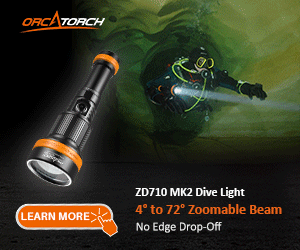Just got back from Albion (near Fort Bragg) on an annual camping/Abalone diving trip. Great fun, got my first Ab. 47 degree water, big waves, all good. No pictures except topside shots of the divers and the eight abalone we had for dinner. Let's see, at $120 a lb., that's about a camera/housing/strobe worth of dinner! Pretty much everyone limited except for my wife and I.
Sharkbyte:
On the strobe, for wide shots, the stronger the merrier. For macros, whatever you're using will probably be set on minimum, with a diffuser. In California water, the only way you're going to get good lighting for wide shots is with a good strong strobe on a long arm to prevent backscatter and a wide angle lens to get the whole subject from a closer distance. The key is get closer. I suck at lighting, so I'm sure someone else can answer this better. Any strobe is better than none, but they do make lighting more challenging. The built in flash will work great on everything but supermacros, but in our water, you'll get lots of backscatter on anything more than about 18 inches.
There are lots of posts on strobes, and they're fairly universal-basically hardwired ttl type or optically fired slave type. They both work fine, but ttl should be easier as it sets itself for the light conditions the camera sees through the lens at preflash. In the Oly housing, the only ttl option is the Oly flash unless you have the Heinrichs/Weikamp bulkhead replacement, but there are a lot of very nice slave strobes out there that work fine. The SP gives you 10 levels of manual adjustment. Most slaves have multiple adjustment levels for flash strength. Turn the dial, take a shot, check the lighting, readjust and retake. You'll get used to setting it for various conditions once you're familiar with whatever you buy.
Linda:
I haven't had any such problems, so I can't really answer that. It's odd that it happens in only scene mode. I have never used AA's. I have a R-CRV-3. The firmware fix is supposed to keep the low battery light from going on due to the lower voltage of the AA's. The CRV-3 the camera comes with is 3v. The alternative AA's are generally only 1.2v each for a total of 2.4, so the camera thinks the battery is low. The batteries seem to absorb more charge after they are charged a few times. I would certainly be concerned, take note and keep an eye on it, in case it needs to be returned for a warranty repair. In the meantime, I would charge it, use it and see how long it will go without quitting. I generally charge after 2-3 dives plus downloads. About 1 1/2 hours of continuous on use. When the battery dies, you'll know it. The camera will go black, but the lens won't retract until you recharge the batteries and put them back in. My charge indicator is pretty much always green till the thing dies. I just use it and keep a regular charging routine. Generally, I'll have it all charged up before any problems.



